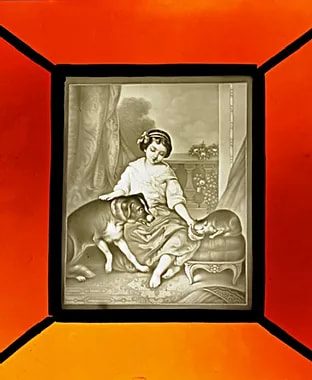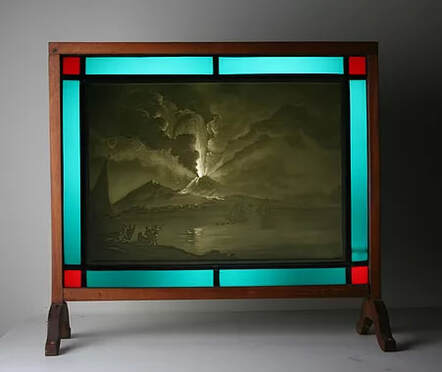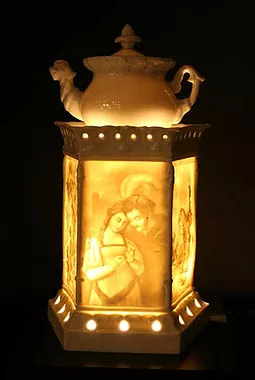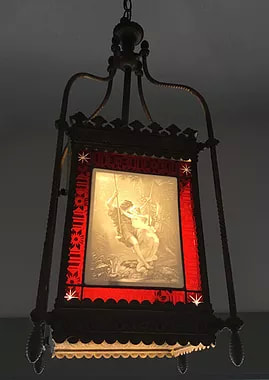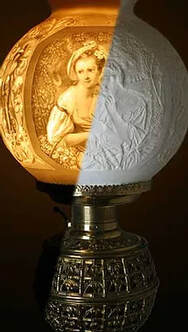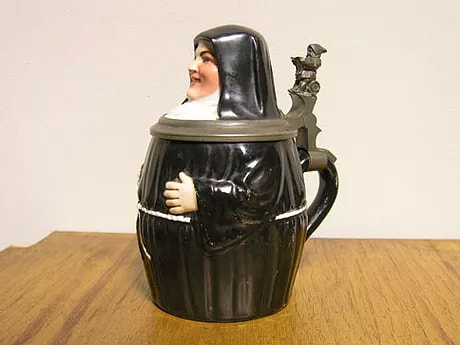|
PLAQUES
The plaque is the most basic lithophane shape, be it rectangular, square, oval, circular, or trapezoid. Examples include candle shields, table screens, lamps and shades, night lights, and tea warmers, fireplace screens, doll house miniatures, complexion fans, beer steins bottoms, interiors of souvenir or commemorative memorabilia, lanterns, and matchboxes. Perhaps the most appealing plaques are for hanging in windows are those with colored or stained glass surrounding the lithophane. |
CANDLE SHIELDS
Candle shields were intended to protect one's eyes from the harsh flame of the candle, whether it was in a single stand on the table or mantle, attached to a wall sconce, or suspended from the chandelier. The candle shields that held the lithophane porcelain panels were themselves constructed, often quite elaborately, out of cast-iron, wood,, antlers. silver. bronze, brass, tin or other materials. The Blair Museum of Lithophanes owns more than 50 candle shields. |
|
TABLE/FIREPLACE SCREENS
The table screen or fireplace screen had a similar function to that of the candle shield. Rare fireplace screens have cast-iron framing and are very large. Table Screens are large plaques mounted in wooden frames- these beautiful objects are used to protect the desk sitter from drafts or annoyance of flickering flame. Some of the most spectacular lithophanes in the Blair Museum collection are mounted as table screens. This would include one of the ultimate lithophane plaques, Mount Vesuvius in full eruption over the Bay of Naples at night on August 10, 1832. Only one other lithophane version of this image of Mount Vesuvius is known in existence. |
COMPLEXION FANS OR HAND SCREENS
Complexion fans or hand screens were a clever invention popular in the Victorian times which protected the waxy make up of both men and women from the threat of melt down from the heat of the fires, lamps or candles of the time. While no one waved these complexion fans through the air, these beautiful and useful devices also protected ones eyes from the light and heat. The porcelain plaque was mounted at the end of the handle, much in the manner that a lithophane is fastened into a candle shield stand. The fashionable person would hold the screen or fan in front of his or her face, literally shielding the face from the heat source. The person was then treated to a splendid view of the image on the porcelain, illuminated by the glow of the light source. |
|
NIGHT LIGHTS, FOOD AND TEA WARMERS
Night lights in the 19th century would’ve had multiple uses. While they could have been used for illuminating a small area in order to read, many appear to be more ornamental than practical. Tea and food warmers are used for warming food or beverages by means of a bowl, cup, or teapot that rest on a hollow pedestal containing a lamp. These are often described as combination night light and tea-warmers. The Museum has a large collection of these on display. |
LANTERNS
One of the most beautiful and captivating uses for the lithophanes as panels and hanging lamps are lanterns. These lithophane lanterns once fueled by oil and other sources, are relatively scarce. If one tours the Blair Museum there’s a hanging lantern in the foyer and another in the lobby with five others in a hallway. The docent presenting the tour invariably notes that the lantern in the lobby is illustrated in the Encyclopedia Britannica. Mr. Blair was proud of the fact that he was instrumental in persuading them to include an entry under the heading “lithophanes”. |
|
LAMP SHADES
One of the earliest uses for the flat or curved plaques were as panels in lampshades; be it 4, 5, 6 or even 8 sided. There would be a metal frame or armature where these plaques would slide in and out of brackets. The largest single cast lithophane lampshade in the world is located in the Blair Museum. It measures 17.75 inches diameter and is 10.25 inches in height. |
STEINS
What is the one undeniable fact about what happens when one magically discovers a lithophane at the bottom of a teacup, saki cup, coffee mug, or beer stein? After the surprise and delight phases have concluded one is destined to pick up every cup and stein seen in an antique shop, just to check and see if it contains a precious lithophane in the bottom. Many lithophane stein images are related to the theme of the stein exterior. |

